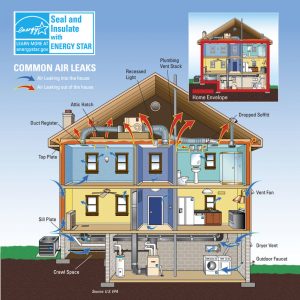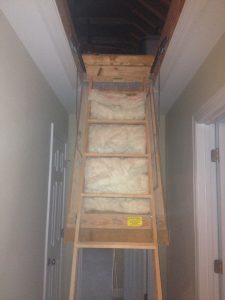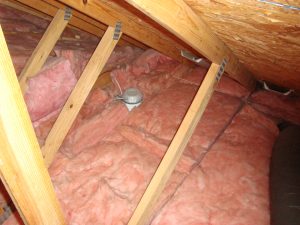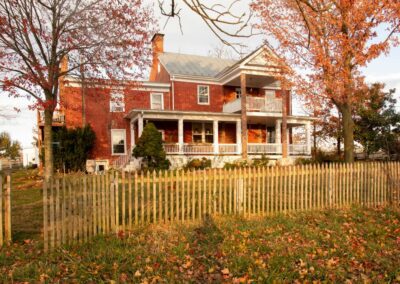 Help, my house is cold! This time of year, with weather like we have been having, the electric meter gets a strong workout. Yet, often our homes are not comfortable, cold even. So what can you do to make your electric bills lower and your home more comfortable?
Help, my house is cold! This time of year, with weather like we have been having, the electric meter gets a strong workout. Yet, often our homes are not comfortable, cold even. So what can you do to make your electric bills lower and your home more comfortable?
I am now working for Harrisonburg Electric Commission providing their clients with free energy audits. It really is a air leakage test and identification of easy to correct high energy usage issues – but energy audit sounds better. In the test we use a blower door to depressurize the house. This allows us to find areas where air is moving from outside to inside of the home. These air leaks are a huge part of the discomfort and high energy use for your home. The typical heating and cooling system in an average home accounts for 60-70% of the monthly electric usage. The typical home could easily reduce this portion of the electric bill by 10-30% by plugging up these leaks. Air leaking through the walls, from the crawl space or attic, around electrical outlets are the same as leaving a window open on a cold winter day.
Here are 10 spots that are almost always air leaks in a home and how to fix it.
 Attic access or pull down stair – Seal it up like a door, add weather-stripping and glue rigid insulation to the top of the access or create a hinged door over a pull down stair
Attic access or pull down stair – Seal it up like a door, add weather-stripping and glue rigid insulation to the top of the access or create a hinged door over a pull down stair- Electrical outlets / light switches – These holes in your drywall / plaster allows for an easy air path. Caulk the plastic box tight to the drywall and add insulation made for behind the electrical cover
- Wall / Floor intersection – Remove the 1/2 round and caulk the drywall tight to the floor
- Drywall corners – The only good way to fix this is to stop the air moving from above and below the corner. This can be done well in new construction but is really hard to fix in an existing home
- Wood floor over crawl space – In our climate the crawl space should be sealed and conditioned space. This eliminate air leaking from outside.
- Recessed lights – These are always a big leak, unless they are air tight cans sealed tight to the drywall. The best way to eliminate this problem is to stop air movement on the backside of the drywall (between floor joist or in the attic).
 Rim board between basement and first floor and first floor to second floor – This is probably the biggest air leak in your home. It is hard to fix in an existing finished space. If you can easily access these spaces, get it filled with open cell spray foam. If it is finished space, you can fix it, but it will require drilling lots of holes or removing drywall.
Rim board between basement and first floor and first floor to second floor – This is probably the biggest air leak in your home. It is hard to fix in an existing finished space. If you can easily access these spaces, get it filled with open cell spray foam. If it is finished space, you can fix it, but it will require drilling lots of holes or removing drywall.- Chimney / Bath Vents / Kitchen Hood Vent – Use the damper in the fireplace to reduce air leakage, install vents with dampers for all exhaust vents
- HVAC ducts – A surprise to many that this is a source of outside air coming into your home. The average duct system installed in your home uses tape to seal the joints’ leaks and leaks big time. If the joints are sealed with Mastic, then you will certainly have less leaks. I know one HVAC company in town that prides themselves on duct tightness, but that is one out of 12+ in town serving the residential market. If you can access the ducts, you can seal them, but this is often not the case. The only solution that I have found for a finished house is sealing from the inside of the duct using a product similar to Aeroseal. I have not seen a before and after, but I have heard of good performance.
- Doors and Windows – Make sure they have the proper weather-stripping. We also use air stopper socks at the bottoms of all our doors. These are holes that open and close, really hard to seal them tight, do your best.
If you ever have to think to yourself “Help, my house is cold!” then fix these air leaks to see a reduction in your monthly electric bills. If you live in Harrisonburg give HEC a call to schedule your free energy audit to verify the leaks so you can get them fixed. If you want a complete energy audit or don’t live in Harrisonburg, Building Knowledge – Benjamin is an expert and does a great job.

 Attic access or pull down stair – Seal it up like a door, add weather-stripping and glue rigid insulation to the top of the access or create a hinged door over a pull down stair
Attic access or pull down stair – Seal it up like a door, add weather-stripping and glue rigid insulation to the top of the access or create a hinged door over a pull down stair Rim board between basement and first floor and first floor to second floor – This is probably the biggest air leak in your home. It is hard to fix in an existing finished space. If you can easily access these spaces, get it filled with open cell spray foam. If it is finished space, you can fix it, but it will require drilling lots of holes or removing drywall.
Rim board between basement and first floor and first floor to second floor – This is probably the biggest air leak in your home. It is hard to fix in an existing finished space. If you can easily access these spaces, get it filled with open cell spray foam. If it is finished space, you can fix it, but it will require drilling lots of holes or removing drywall.


